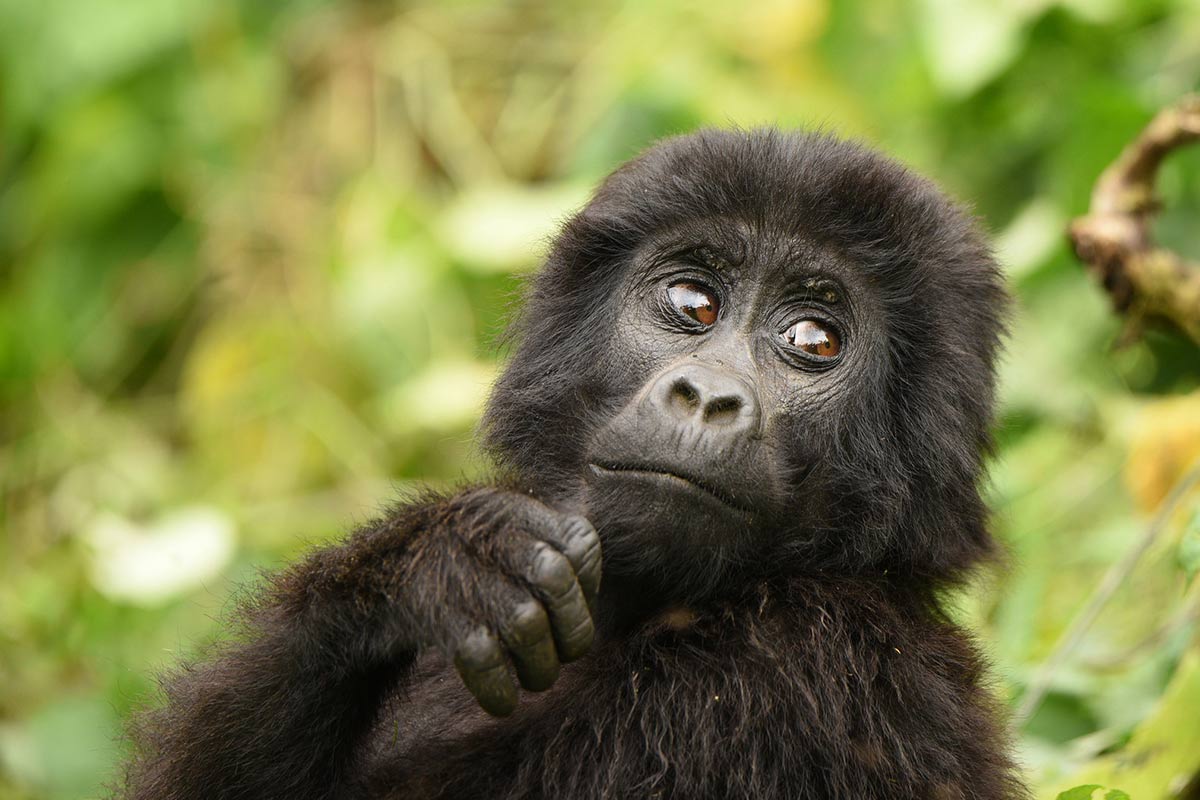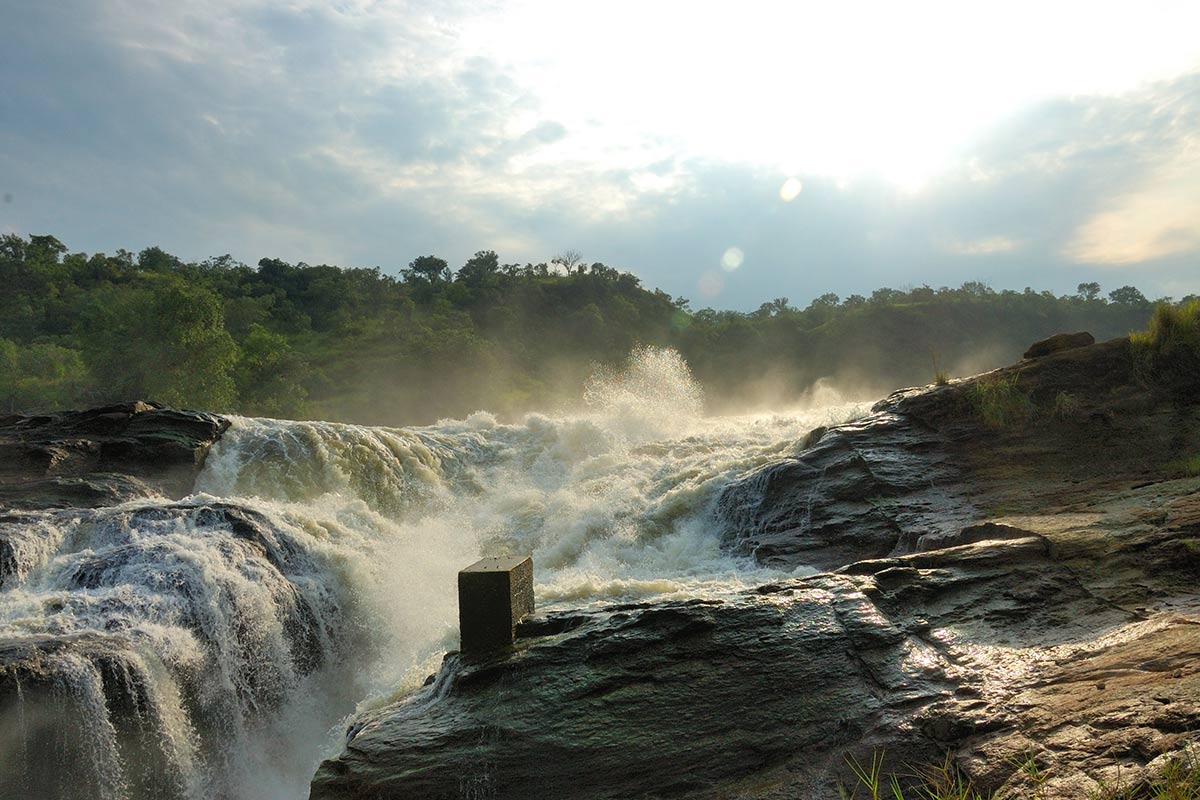KIBALE FOREST NATIONAL PARK | Chimp Tracking in Uganda
Kibale Forest is one of the finest places in the world to watch and observe primates. The forest is home to 13 primate species, more than any other East African park, this includes red-tailed L'Hoest and blue monkeys, grey-cheeked mangabey, red colobus and black and white colobus, along with a substantial population of habituated chimpanzees. The chimp tracking takes place twice a day, morning and late afternoon and is the park's main attraction. In addition, the safari park authorities offer fantastic night walks, which is a great opportunity to search for nocturnal primates such as the wide-eye bush baby and the sloth-like potto.
KIBALE FOREST HIGHLIGHTS
Chimp tracking and a substantial population of habituated chimpanzees
Chimp habituation experience and night walks also available
Home to 13 primate species - more than any other East African park
Night walks to see nocturnal primates
Spectacular birding at Bigodi Wetlands Sanctuary
The outstanding natural beauty of Ndali-Kasenda Crater Lakes
Chimp Tracking in Kibale Forest
Guests are taken to the park headquarters in Kibale Forest where you meet the park ranger who will act as your guide for the chimp-tracking. You enter the forest and following signs and chimp calls your guide leads you to the chimpanzees. Chimpanzee sightings are not guaranteed, however the odds of encountering them have greatly increased in recent years, now standing at 90% or over.
Whilst chimpanzees tracking you are likely to see at least two or three other types of primate, most probably the grey-cheeked mangabey and red-tailed monkey. You hear plenty of birdsong but it is very difficult to see any birds in the heart of the forest due to the dense vegetation.
Once with the chimpanzees you will be able to spend an hour watching them. You then walk back to the park headquarters with the whole experience usually taking around three to four hours.
More Than Chimps in Kibale Forest
On a Kibale safari there's also the rare opportunity to see the elusive forest elephant, smaller and hairier than its savannah counterpart. Other mammals include buffalo, giant forest hog and several antelope species. The network of forest trails are a delight to botanists, birders and butterfly lovers. Located on the fringes of the park the Bigodi Wetlands Sanctuary can be found. It is a superb community tourism initiative, established to protect the Magombe Swamp; a haven for both birds and primates. The walks through the sanctuary are led by knowledgeable guides, and for birders the morning walks are particularly recommended.
Another attraction to take in is the Ndali-Kasenda Crater Lakes. The nearest set of lakes to Kibale are set to its west, and are known as the Kasenda Cluster. Formed over 10,000 years ago, this is an area of outstanding natural beauty and ideal for stealing some quiet time.
Selected Kibale Chimps Tracking Itineraries
Our favorite itineraries, contact our consultants for a tailored itinerary
Chimpanzee Habituation Experience in Kibale
The Uganda's Kibale Forest Chimpanzee Habituation Experience is one thing to spend an hour with the chimpanzees of Uganda it is another experience to be with them all day long. Most people do not realize that they have a choice between chimpanzee tracking and a Chimpanzee habituation experience. People come to Uganda for the Mountain Gorillas and Chimpanzee tracking. There are 4950 chimpanzees within Uganda, Kibale Forest alone has the most with almost 1500 Chimpanzees.
Most visitors visit the chimpanzees much like the Mountain Gorillas for one hour – there is however another option that allows you to be with chimpanzees all day long in the forests of Budongo or Kibale Forest – it is the habituation experience – all day with chimpanzees in their natural setting.The Chimpanzee Habituation Experience is not for the faint of heart – it means an early breakfast – a packed lunch and you are off before dawn breaks into the forest. You meet your guide and you are off to where the chimpanzees built nests the night before. Dawn is just breaking and the chimpanzee community you are going to be with the rest of the day is rising from their sleep.
However you are here for the Chimpanzee Habituation Experience – which entails getting the chimpanzees used to the presence of humans (to remove the fear of humans from the group), a process that takes up to two years – and today you are part of that process by your all day presence in the forest. Years ago, it used to be that you had a 20% chance of seeing chimpanzees in the wild, today because of the habituation process that has increased to over 90%.
Your day will be full, your camera will fill up with quality pictures of the chimpanzees and you will get to learn to identify them as individuals by their markings, sometimes scars and other unique features that make them stand apart from rest. The day ends as the chimpanzees climb into their newly built nests for the evening and you head back to your lodging for the evening.
How Much and When Can you go for a Chimpanzee Habituation Experience?
The Chimpanzee Habituation Experience costs USD $220 (Ush 572,000) for foreign non-residents, USD $150 (Ush 390,000) for foreign residents and USD $70 (Ush 182,000) for East Africans
The habituation experience is best in the months of March, April, May and November, when there is less tourist congestion. In a small group (a ranger plus a maximum of four people), you get much closer to the chimps than during chimp tracking in larger groups.
The best time to visit Kibale Forest
The drier months of December to February and June to July are best for chimpanzee tracking. However, you can still go looking for the primates in the wetter months (March to May and August to November), which have the added attraction of low-season prices. The East African sky is also less hazy outside the drier periods.
Best time to go: December to February and June to July (Trails are dry, so it makes tracking chimps easier)
High Season: June to September (The park is busier as it is the most favorable time for gorilla tracking)
Low Season: March, April, May, October and November (Some camps and lodges are closed)
Best Weather: June to July and December to February (Least rain)
Worst Weather: April, May and September to November (Most rain, forest trails are slippery, and travel becomes difficult)
DRY SEASON
June to August and December to February
- Dry trails make it easier to track chimps
- Days are lovely and sunny
- The views aren't that great as the sky is hazy
WET SEASON
March to May and September to November
- Great time for birders with migratory birds present
- The views are spectacular when the clouds lift
- Rain can make roads impassable and forest trails challenging
- It might drizzle for days – it tends to be misty and wet
Kibale Forest Weather

The climate in Kibale is moist and temperate. The temperatures stay the same, almost year-round since it’s close to the equator. During the day temperatures are nearly 27°C/81°F, cooling off nightly to about 15°C/59°F. In the south, the altitude level drops down to the rift valley floor, and forest gives way to open grassland. As a result, rainfall is lower, and temperatures are higher.
Kibale lacks a real Dry season, so rain is possible anytime, although the months of December through February are typically drier. June and July also experience wet weather. Two Wet seasons exist: March to May and August through November. It is recommended to bring waterproof clothing and shoes.
Health and safety
In our view, as with most other parks and reserves in Uganda, Kibale NP can be considered very safe to visit. Most of the people you come across are tourists or employees of tour operators, accommodations or the park.
Malaria & vaccinations: Precautions against malaria are important. Antimalarial medications are advisable and you should also use mosquito repellent containing at least 30% DEET, as well as covering exposed skin in the evening when mosquitoes are active. You will almost certainly require certain vaccinations too – consult your local travel clinic.
Selected Kibale Forest Accommodation
Chimp Tracking Safety Precautions
How to limit dangers and annoyances
Animal behavior is not always predictable, so viewing wildlife can present certain risks. These will be limited greatly by listening to your guide’s directions, following their instructions and being aware of the ‘primate tracking safety precautions
Please note: By reading the advice below, you may get the impression that primate tracking is a dangerous activity. This is not the case. Tracking gorillas and chimpanzees can be considered very safe as long as you treat them with respect and use common sense. It is extremely rare that dangerous incidents occur, and your professional guide is there to ensure your safety. The advice below is solely intended to further lessen the already minimal risk.
Mountain gorillas are, in essence, gentle giants. They show very little aggression toward each other and their overall vibe is extremely peaceful. Chimpanzees are, by nature, a lot more aggressive but the groups you can visit are habituated. Aggression towards humans in that context is extremely rare.
- Always follow your guide's instructions and guidelines.
- Great apes are susceptible to human diseases. Never visit if you are ill and turn away if you need to cough.
- If you need to go to the toilet, dig a hole in the ground and cover it up if you need to go to the toilet. Apes can get diseases from your feces.
- Always keep the recommended distance (at least 5 meters / 15 feet) between you and the primates. Back off if the animals approach you to close that distance.
- Slowly back off if any gorilla shows aggression towards you.
- If a gorilla charges follow the guides example (crouch down slowly, do not look the gorillas directly in the eyes and wait for the animals to pass).
- Never look large primates in the eyes.
- Don't use a flash when photographing.
- Don't talk or laugh too loud.
- Don't make any quick movements.
- Stay close to your guide and group.
- Never block the path of gorillas when they are walking.
- Never take food or drink close to chimps or gorillas. You can leave your daypack behind with the trackers when you approach the animals.
- Watch where you put your feet while walking in the forest.
- In the forest, cover your arms and legs to avoid nettles and use insect repellent to protect against mosquitoes. The repellant should contain at least 20-30% DEET.
- Wear a hat, use sunscreen, and drink plenty of water.
- Bring good waterproof clothing and a waterproof bag for your camera and other belongings.













